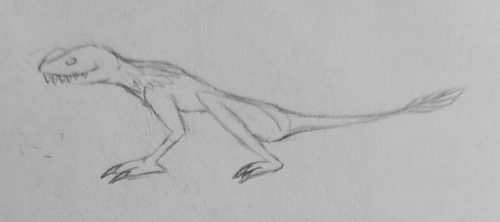Ralukir
A carnivorous, mountain-dwelling reptile which hunts in packs.
Basic Information
Anatomy
Ralukir are quadrupedal reptilians. Their hind legs are almost twice as long as the front legs and usually folded when the animal is at rest. Each foot has three toes tipped with claws. Furthermore, the front feet possess a fourth, clawless toe pointing backwards.
The elongated, triangular skull sports a powerful jaw with sharp teeth protruding from the upper side. Another defining characteristic is a blunt bone protrusion above the nose, reaching from the tip of the skull to the eyes.
The animal's tail is about the length of the torso. A fan of feathers is located at its tip.
Feathers also cover the thick, muscular neck, while the rest of the skin is covered in smooth scales.
Biological Traits
The exact coloration varies around the mountain massif. On the eastern side, Ralukir tend towards green hues, whereas those on the western side are more reddish in appearance.
Genetics and Reproduction
Females lay 1-2 eggs after each mating season, which take about 44 days to hatch. Adult members of the pack take turns in guarding the communal nest.
Growth Rate & Stages
Ralukir mature over the course of 16 years. The most notable change is in the proportions of the limbs which grow longer and comparably thinner. Besides that, the camouflage pattern of the infants' plumage is replaced by darker, more saturated colors.
Ecology and Habitats
They are found around the mountainous area in the center of Ranul's inner face.
Dietary Needs and Habits
Ralukir are purely carnivorous. They hunt in well-coordinated packs of up to 20 adults.
Their main food source are the lumbering Pungiz beetles . Those need a moment to take off flying, of which the ralukir take advantage by leaping in suddenly from multiple sides. The predators' powerful hind legs serve to propel them over several times their body's length, enabling them to intercept their prey as it rises into the air.
Additional Information
Social Structure
Packs consist of about 8-20 adults and about 12-30 younger animals.
They are led by an alpha couple, and the lowest-ranking pack members usually leave to form their own packs when too many adolescents have grown up. Conversely, two or more smaller packs may join into one to increase their numbers.
Social ties are strong within a pack. Prey is shared and offsprings are cared for by all adults together. The hierarchy mostly shows with regards to finding a mate. Rank is also reflected in the share of food that each animal gets, but it is rare for any individuals to go hungry.
Average Intelligence
Ralukir are capable of strategic thinking, making the best use of concealment while sneaking up on their prey. Individuals position themselves in such a way that all escape routes are blocked.
Perception and Sensory Capabilities
They possess keen vision even in dim light. Additionally, the protrusion on their nose is covered with countless heat receptors.
A thin, frilled tongue serves for both smell and taste.
Hearing is less developed in this species, but they are sensitive to subtle vibrations of the ground.
Lifespan
85-130 years
Average Height
0.5 - 0.7 m
Average Length
1.8 - 2.2 m
Geographic Distribution




I would not want to run in a pack of these! I can see why they are an apex predator. I also love that you added your own artwork!
Thank you, I'm glad you like them! I'd love to add some more polished art however, probably some time after this Summer Camp.
Creator of the Kaleidoscope System and the planet Miragia.
That would be wonderful. But yes, first Summer Camp. :D